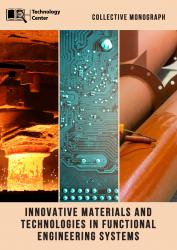Modern technologies of repair and restoration works of buildings in use
Keywords:
epoxy composite coatings, magnetic sensitivity, Hall effect, single crystals of silicon and germanium, radiation resistance, metal powder fillers, montmorillonite, anionic dyes, nanopigment, polymer film former, polymer-mineral coating compositions, anti-corrosion coatings, polymer bodies, polymer fuelAbstract
Rational use of resources requires a new approach to many management issues.
Renewal of residential and industrial production potential based on the reconstruction and technical conversion of buildings using new technologies is the shortest way to increase the quality level and competitiveness of domestic products, the integration of the economy of Ukraine into the European and World Community, to the successful functioning of production entities in market conditions. Carrying out repair and restoration works of buildings within the specified time depends to a large extent on providing them with a sufficient amount of technical resources in a timely manner, the need for which is determined not only by the volume of work, but also by the conditions of operation. Being a specific type of construction production, repair and restoration works are performed in more difficult conditions, which significantly affect the efficiency of construction machines and equipment and the quantitative composition of the used resources.
The production conditions of repair and restoration work do not always allow the use of typical machines, known technological schemes of work performance. For repair and restoration work in the conditions of an operating enterprise in hard-to-reach places, it is necessary to have fundamentally new schemes and appropriate equipment adapted for work in hard-to-reach places, and structures with a complex configuration at height. The use of a typical set of mechanisms reduces the efficiency of their use, reduces productivity, increasing the duration of the repair cycle and the consumption of materials.
The existing methods of determining construction needs in equipment do not allow to properly take into account the production conditions inherent in repair and restoration works, to assess their impact on the efficiency of use.
This leads to an underestimation of resource needs, which negatively affects the work of construction organizations and the quality of work.
During repair and restoration works, the issues of heterogeneity, dispersion and small volume of the performed works become more relevant. Execution of a complex of works uncharacteristic for new construction: replacement or restoration of individual structural elements, replacement of anti-corrosion coatings on individual areas, etc. All work is performed in difficult conditions, which often significantly affects the general scheme of organization and technology of work. Increasing the efficiency of repair and restoration works depends on the level of automation.
The conditions of repair and restoration work in hard-to-reach places are reflected in the principles of the technology of automated processes, taking into account the factors of compactness, limited space, difficult access, various configurations, etc. The most time-consuming processes are: preparation of surfaces, cleaning and application of anti-corrosion coatings. Therefore, the question of choosing rational options for automating these works determines the level of exploitation. All this requires the development of more advanced mechanisms of automated systems.
The process of repair and restoration works is complicated due to the greater variety of volume-planning and constructive solutions. Therefore, a difficult and important problem is the industrialization and improvement of the quality of the coating in the conditions of the objects that are operated.

INNOVATIVE MATERIALS AND TECHNOLOGIES IN FUNCTIONAL ENGINEERING SYSTEMS
Downloads
Pages
Published
Categories
License

This work is licensed under a Creative Commons Attribution-NonCommercial-NoDerivatives 4.0 International License.

